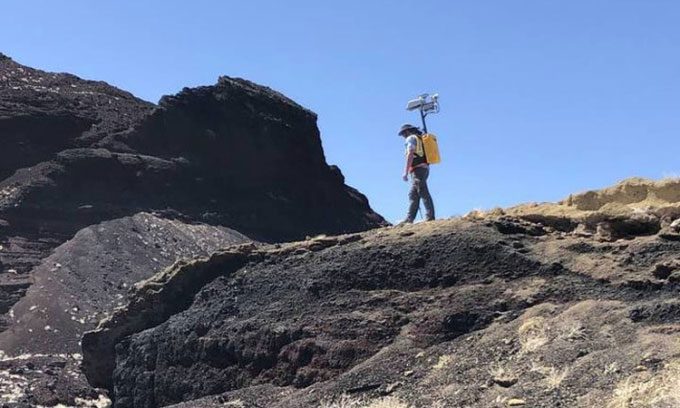The KNaCK Backpack Utilizes Lidar Technology to Assist Astronauts in Navigating the Moon While Mapping in Real-Time.
NASA has partnered with companies Torch Technologies and Aeva to develop a remote sensing mapping system called Kinematic Navigation and Cartography Knapsack (KNaCK), which employs mobile lidar scanning technology to create ultra-high-resolution maps in real-time as astronauts traverse the lunar surface, Digital Trends reported on April 21.

Michael Zanetti, a scientist at NASA, testing the KNaCK prototype in New Mexico, USA, at the end of 2021. (Photo: NASA/Michael Zanetti)
The new device can collect millions of measurement points per second and can also be used for navigation, thereby enhancing the safety of astronauts moving on the Moon, whether walking or driving exploration vehicles. It was developed to support Artemis, the program that aims to land the first crew on the Moon since 1972. The current equipment is in the form of an 18 kg backpack, but scientists plan to miniaturize it to attach to astronauts’ helmets.
KNaCK Will Play a Crucial Role in Lunar Missions as astronauts need to explore areas with poor visibility, such as the south pole, where the Sun never rises more than 3 degrees above the horizon, leaving much of the region in permanent darkness.
“Essentially, KNaCK is a surveying tool for both navigation and scientific mapping, capable of creating ultra-high-resolution 3D maps with centimeter-level accuracy,” said Dr. Michael Zanetti, a planetary scientist and project lead for KNaCK at NASA’s Marshall Space Flight Center.
“The new device will also help ensure the safety of astronauts and exploration vehicles in GPS-denied environments like the Moon, determining the actual distance to distant landmarks and showing explorers how far they have traveled and how much further they need to go,” he added.
Humans tend to use landmarks like buildings and trees for navigation, but those do not exist on the Moon, making KNaCK extremely useful, according to Zanetti. Astronauts could even mark locations where they find unique minerals or rocks so that others can easily locate and study them further.
Engineers have tested the KNaCK prototype to map ancient volcanic craters in New Mexico and recreated a 3D version of a 10 km-long barrier dune at NASA’s Kennedy Space Center in Florida. The research team is working to miniaturize the hardware and make it robust enough to withstand the challenges of microgravity and solar radiation.





















































